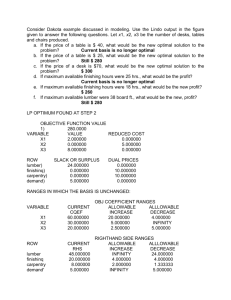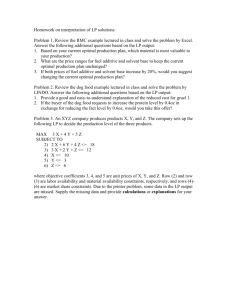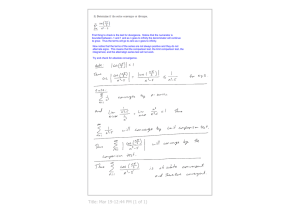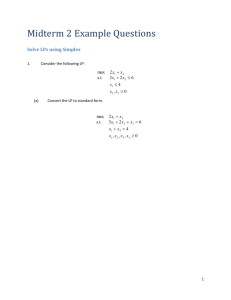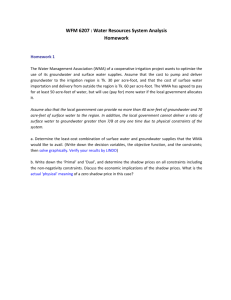Math 340 Assignment #4 Due Wednesday March 23 1. Consider the LP:
advertisement
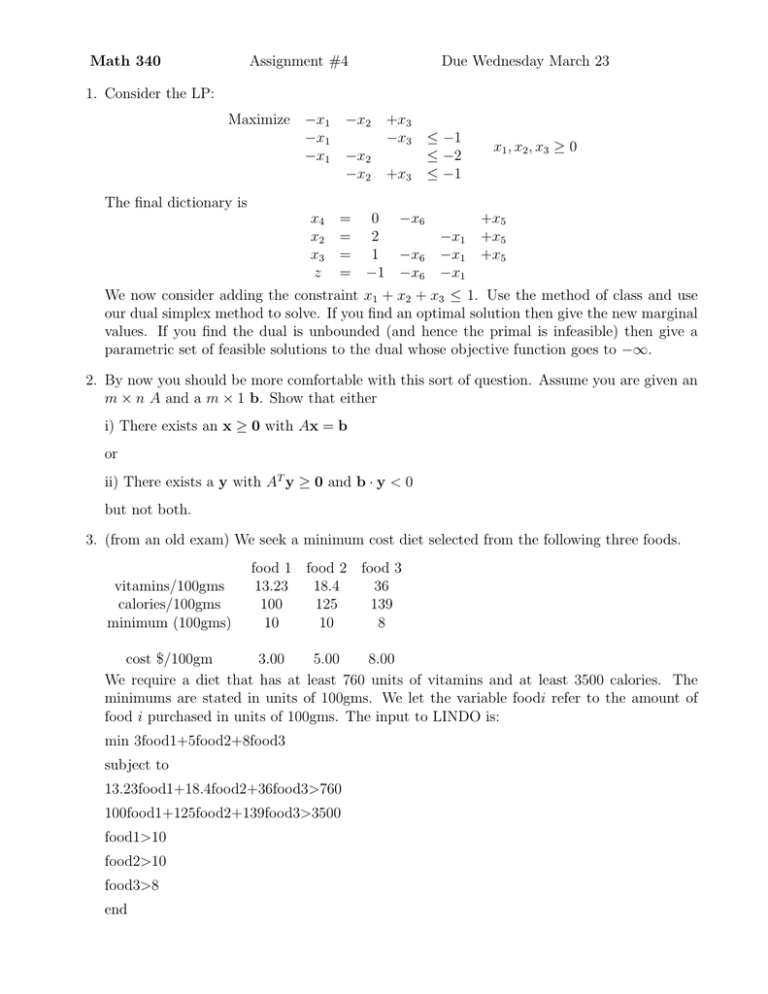
Math 340 Assignment #4 Due Wednesday March 23 1. Consider the LP: Maximize −x1 −x1 −x1 −x2 −x2 −x2 +x3 −x3 +x3 ≤ −1 ≤ −2 ≤ −1 x1 , x2 , x3 ≥ 0 The final dictionary is x4 x2 x3 z = 0 −x6 = 2 = 1 −x6 = −1 −x6 −x1 −x1 −x1 +x5 +x5 +x5 We now consider adding the constraint x1 + x2 + x3 ≤ 1. Use the method of class and use our dual simplex method to solve. If you find an optimal solution then give the new marginal values. If you find the dual is unbounded (and hence the primal is infeasible) then give a parametric set of feasible solutions to the dual whose objective function goes to −∞. 2. By now you should be more comfortable with this sort of question. Assume you are given an m × n A and a m × 1 b. Show that either i) There exists an x ≥ 0 with Ax = b or ii) There exists a y with AT y ≥ 0 and b · y < 0 but not both. 3. (from an old exam) We seek a minimum cost diet selected from the following three foods. vitamins/100gms calories/100gms minimum (100gms) food 1 food 2 food 3 13.23 18.4 36 100 125 139 10 10 8 cost $/100gm 3.00 5.00 8.00 We require a diet that has at least 760 units of vitamins and at least 3500 calories. The minimums are stated in units of 100gms. We let the variable foodi refer to the amount of food i purchased in units of 100gms. The input to LINDO is: min 3food1+5food2+8food3 subject to 13.23food1+18.4food2+36food3>760 100food1+125food2+139food3>3500 food1>10 food2>10 food3>8 end The following is the output from LINDO: OBJECTIVE FUNCTION VALUE 1) 178.6000 VARIABLE VALUE F OOD1 10.000000 F OOD2 10.000000 F OOD3 12.325000 REDUCED COST 0.000000 0.000000 0.000000 ROW SLACK OR SURPLUS DUAL PRICES 2) 0.000000 −0.222222 3) 463.174988 0.000000 4) 0.000000 −0.060000 5) 0.000000 −0.911111 6) 4.325000 0.000000 RANGES IN WHICH THE BASIS IS UNCHANGED: OBJ COEFFICIENT RANGES VARIABLE CURRENT ALLOWABLE ALLOWABLE COEF INCREASE DECREASE F OOD1 3.000000 IN F IN IT Y 0.06000 F OOD2 5.000000 IN F IN IT Y 0.911111 F OOD3 8.000000 0.163265 8.000000 RIGHTHAND SIDE RANGES ROW 2 3 4 5 6 CURRENT ALLOWABLE ALLOWABLE RHS INCREASE DECREASE 760.000000 IN F IN IT Y 119.958984 3500.000000 463.174988 IN F IN IT Y 10.000000 11.768706 9.468493 10.000000 8.461956 8.584380 8.000000 4.325000 IN F IN IT Y a) There is a special on food 2 reducing the price to $4.10/100gms. Would this change your purchase strategy? What about a price reduction to $3.10? b) What is the marginal cost of 10 units of vitamins; namely what is the cost of increasing the vitamin requirement by 10? Considering the chosen diet as a whole, what is the dollar cost (approximately only) of the whole diet per 10 units of vitamins obtained. Which cost is cheaper? c) Is integrality important in diet problems such as this? d) Give a linear inequality that expresses the requirement that at least 20% of the weight of the purchased diet comes from food 2. 4. (from an old exam) We have a gasoline blending problem where we may mix four gasoline products x1 , x2 , x3 , x4 from 3 types of gas (gas1,gas2,gas3). The availability of the three gases is given as a function of a parameter p: Maximize 12.1x1 +8.3x2 +14.2x3 18.1x4 (= z) (gas1) 2x1 +x2 +3x3 +6x4 ≤ 37 + 2p x1 , x2 , x3 , x4 ≥ 0 (gas2) 3x1 +2x3 +x4 ≤ 42 + p (gas3) x1 +4x2 +2x3 +x4 ≤ 39 − 3p We are interested in the value of the objective function z as a function of the parameter p near p = 1. We make p a variable (and move it to the other side of the inequalities), and make p free (allowing it to be negative). We also impose the somewhat arbitrary condition p ≤ 1 and then use this constraint in our analysis. We send this off to LINDO. The LINDO output will be useful for parts b),c). a) What happens to z in our original LP when p = −37 ? 2 What happens for p < −37 ? 2 Explain. b) What is z for p = 1? What is the slope of the graph of z as a function of p at that point? For what range on p is the slope valid. c) Explain the interesting coincidence that: 2(2.525000) + 1(1.868750) − 3(1.443750) = 2.587500. The input to LINDO is: max 12.1x1 + 8.3x2 + 14.2x3 + 18.1x4 subject to gas1) 2x1+x2+3x3+6x4-2p<37 gas2) 3x1+2x3+x4-p<42 gas3) x1+4x2+2x3+x4+3p<39 param)p<1 end free p The following is the output from LINDO: OBJECTIVE FUNCTION VALUE 1) 230.8062 VARIABLE VALUE X1 11.875000 X2 4.187500 X3 3.687500 X4 0.000000 P 1.000000 REDUCED COST 0.000000 0.000000 0.000000 0.362500 0.000000 ROW SLACK OR SURPLUS DUAL PRICES GAS1) 0.000000 2.525000 GAS2) 0.000000 1.868750 GAS3) 0.000000 1.443750 P ARAM ) 0.000000 2.587500 RANGES IN WHICH THE BASIS IS UNCHANGED: OBJ COEFFICIENT RANGES VARIABLE CURRENT ALLOWABLE ALLOWABLE COEF INCREASE DECREASE X1 12.100000 0.161111 2.990000 X2 8.300000 0.322222 4.620000 X3 14.200000 4.271429 0.093548 X4 18.100000 0.362500 IN F IN IT Y P 0.000000 IN F IN IT Y 2.587500 RIGHTHAND SIDE RANGES ROW GAS1 GAS2 GAS3 P ARAM CURRENT ALLOWABLE ALLOWABLE RHS INCREASE DECREASE 37.000000 16.750000 4.916667 42.000000 8.428572 19.000000 39.000000 19.666666 13.400000 1.000000 3.045455 2.269231 5. (from an old exam) We are running a factory and can produce products of three possible types from four types of parts as follows. part part part part 1 2 3 4 profit $ product 1 3 4 5 4 product 2 5 6 8 7 product 3 2 2 3 4 21 35 15 available parts 286 396 440 396 We wish to choose our product mix to obtain maximum profit subject both to the limitations on the inventory of available parts but also subject to the restriction that at most 50% of the number of produced products can be of one type The LINDO input/output on this page and the next page will be useful for parts a),b),c). a) What are the marginal values of the four parts? b) Mr. Edison visits the factory and offers to make a remarkable new part that substitutes for one of any of the four parts and will only charge $2 for each of these new parts. Would you buy some? How many would you buy? c) The market for product 1 crashes and the profit drops to that of product 3. Should you change your production? d) Compute the marginal cost for the total parts that make up product 2 and compare with 17 for this calculation). Why aren’t they the profit for product 2 (Please let 1.545455 be 11 equal? e) Explain the meaning of the constraint PROD1<50 in the context of this problem. The input to LINDO was as follows. The constraints have been labeled to aid readability: MAX 21 PROD1 + 35 PROD2 + 15 PROD3 SUBJECT TO PART1) 3 PROD1 + 5 PROD2 + 2 PROD3 < 286 PART2) 4 PROD1 + 6 PROD2 + 2 PROD3 < 396 PART3) 5 PROD1 + 8 PROD2 + 3 PROD3 < 440 PART4) 4 PROD1 + 7 PROD2 + 4 PROD3 < 396 PROD1<50) 0.5 PROD1 - 0.5 PROD2 - 0.5 PROD3 < 0 PROD2<50) - 0.5 PROD1 + 0.5 PROD2 - 0.5 PROD3 < 0 PROD3<50) - 0.5 PROD1 - 0.5 PROD2 + 0.5 PROD3 < 0 END The following is the output from LINDO: OBJECTIVE FUNCTION VALUE 1932.000 VARIABLE VALUE PROD1 22.000000 PROD2 36.000000 PROD3 14.000000 REDUCED COST 0.000000 0.000000 0.000000 ROW SLACK OR SURPLUS DUAL PRICES PART1) 12.000000 0.000000 PART2) 64.000000 0.000000 PART3) 0.000000 3.000000 PART4) 0.000000 1.545455 PROD1<50) 14.000000 0.000000 PROD2<50) 0.000000 0.363636 PROD3<50) 22.000000 0.000000 RANGES IN WHICH THE BASIS IS UNCHANGED: OBJ COEFFICIENT RANGES VARIABLE CURRENT ALLOWABLE ALLOWABLE COEF INCREASE DECREASE PROD1 21.000000 0.363636 6.000000 PROD2 35.000000 INFINITY 0.500000 PROD3 15.000000 1.333333 2.615385 RIGHTHAND SIDE RANGES ROW CURRENT ALLOWABLE ALLOWABLE RHS INCREASE DECREASE PART1 286.000000 INFINITY 12.000000 PART2 396.000000 INFINITY 64.000000 PART3 440.000000 24.000000 44.000000 PART4 396.000000 44.000000 23.692308 PROD1<50 0.000000 INFINITY 14.000000 PROD2<50 0.000000 22.000000 19.250000 PROD3<50 0.000000 INFINITY 22.000000 6. (from an old exam) We are asked to choose among various carbon reduction strategies to maximize the tons of atmospheric carbon removed subject to various constraints. capital labour space habitat damage strategy 1 100 50 2 3 strategy 2 125 100 3 1 strategy 3 150 110 4 1 tons carbon removed 15 21 26 maximum 1000 600 23 8 There is an additional political decision that we must choose at least 1.5 units of Strategy 1. Here is the problem formulation for LINDO. MAX 15 STRAT1 + 21 STRAT2 + 26 STRAT3 SUBJECT TO CAPITAL) 100 STRAT1 + 125 STRAT2 + 150 STRAT3 <= LABOUR) 50 STRAT1 + 100 STRAT2 + 110 STRAT3 <= SPACE) 2 STRAT1 + 3 STRAT2 + 4 STRAT3 <= 23 HABITAT) 3 STRAT1 + STRAT2 + STRAT3 <= 8 POLITICS) STRAT1 >= 1.5 END 1000 600 Each question below is independent of each other. The LINDO input/output on this page and the next page will be useful. a) If tons of carbon removed per unit of strategy 1 is reduced from 15 to 14 what is now the total tons of carbon removed by an optimal strategy? b) We discover that the habitat damage is less crucial because new habitat for the endangered species has been discovered on Pender Island. What is the benefit of allowing the habitat damage to increase to 8.5 units from 8 units? c) We are told that strategy 1 costs $5000 per unit, strategy 2 costs $6000 per unit and strategy 3 costs $10000 per unit. Is the cost in $ per ton of carbon removed less than $400 per ton for our optimal strategy? d) You are told of a new strategy of carbon removal using fertilizer to stimulate algae growth that will require (per unit of new strategy) 100 units of capital, 100 units of labour, 2 units space and 1 unit cost to habitat that will remove 19 tons of carbon. Should you investigate further? Explain. e) A change in government has resulted in a new policy that we must choose 2 units of strategy 1. How does this affect the number of tons of carbon removed? The following is the output from LINDO: OBJECTIVE FUNCTION VALUE 1) VARIABLE STRAT1 113.5000 VALUE 1.500000 REDUCED COST 0.000000 STRAT2 STRAT3 ROW CAPITAL) LABOUR) SPACE) HABITAT) POLITICS) 0.000000 3.500000 SLACK OR SURPLUS 325.000000 140.000000 6.000000 0.000000 0.000000 NO. ITERATIONS= 5.000000 0.000000 DUAL PRICES 0.000000 0.000000 0.000000 26.000000 -63.000000 0 RANGES IN WHICH THE BASIS IS UNCHANGED: VARIABLE STRAT1 STRAT2 STRAT3 ROW CAPITAL LABOUR SPACE HABITAT POLITICS CURRENT COEF 15.000000 21.000000 26.000000 OBJ COEFFICIENT RANGES ALLOWABLE ALLOWABLE INCREASE DECREASE 63.000000 INFINITY 5.000000 INFINITY INFINITY 5.000000 CURRENT RHS 1000.000000 600.000000 23.000000 8.000000 1.500000 RIGHTHAND SIDE RANGES ALLOWABLE ALLOWABLE INCREASE DECREASE INFINITY 325.000000 INFINITY 140.000000 INFINITY 6.000000 1.272727 3.500000 1.166667 0.500000
